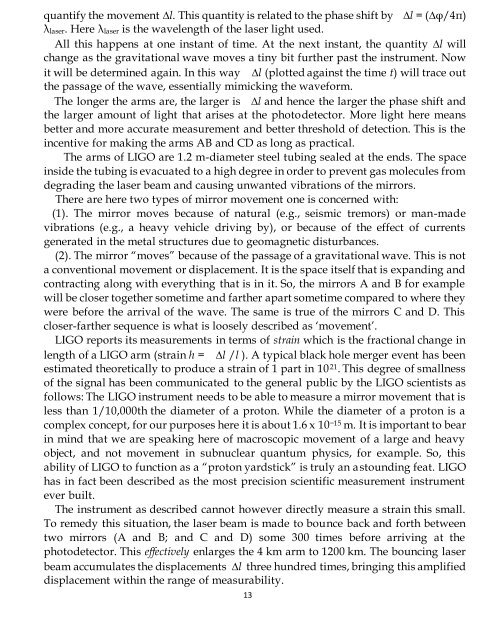LIGO_casebook
You also want an ePaper? Increase the reach of your titles
YUMPU automatically turns print PDFs into web optimized ePapers that Google loves.
quantify the movement l. This quantity is related to the phase shift by l = (φ/4π)<br />
λ laser . Here λ laser is the wavelength of the laser light used.<br />
All this happens at one instant of time. At the next instant, the quantity l will<br />
change as the gravitational wave moves a tiny bit further past the instrument. Now<br />
it will be determined again. In this way l (plotted against the time t) will trace out<br />
the passage of the wave, essentially mimicking the waveform.<br />
The longer the arms are, the larger is l and hence the larger the phase shift and<br />
the larger amount of light that arises at the photodetector. More light here means<br />
better and more accurate measurement and better threshold of detection. This is the<br />
incentive for making the arms AB and CD as long as practical.<br />
The arms of <strong>LIGO</strong> are 1.2 m-diameter steel tubing sealed at the ends. The space<br />
inside the tubing is evacuated to a high degree in order to prevent gas molecules from<br />
degrading the laser beam and causing unwanted vibrations of the mirrors.<br />
There are here two types of mirror movement one is concerned with:<br />
(1). The mirror moves because of natural (e.g., seismic tremors) or man-made<br />
vibrations (e.g., a heavy vehicle driving by), or because of the effect of currents<br />
generated in the metal structures due to geomagnetic disturbances.<br />
(2). The mirror “moves” because of the passage of a gravitational wave. This is not<br />
a conventional movement or displacement. It is the space itself that is expanding and<br />
contracting along with everything that is in it. So, the mirrors A and B for example<br />
will be closer together sometime and farther apart sometime compared to where they<br />
were before the arrival of the wave. The same is true of the mirrors C and D. This<br />
closer-farther sequence is what is loosely described as ‘movement’.<br />
<strong>LIGO</strong> reports its measurements in terms of strain which is the fractional change in<br />
length of a <strong>LIGO</strong> arm (strain h = l /l ). A typical black hole merger event has been<br />
estimated theoretically to produce a strain of 1 part in 10 21 . This degree of smallness<br />
of the signal has been communicated to the general public by the <strong>LIGO</strong> scientists as<br />
follows: The <strong>LIGO</strong> instrument needs to be able to measure a mirror movement that is<br />
less than 1/10,000th the diameter of a proton. While the diameter of a proton is a<br />
complex concept, for our purposes here it is about 1.6 x 10 −15 m. It is important to bear<br />
in mind that we are speaking here of macroscopic movement of a large and heavy<br />
object, and not movement in subnuclear quantum physics, for example. So, this<br />
ability of <strong>LIGO</strong> to function as a “proton yardstick” is truly an astounding feat. <strong>LIGO</strong><br />
has in fact been described as the most precision scientific measurement instrument<br />
ever built.<br />
The instrument as described cannot however directly measure a strain this small.<br />
To remedy this situation, the laser beam is made to bounce back and forth between<br />
two mirrors (A and B; and C and D) some 300 times before arriving at the<br />
photodetector. This effectively enlarges the 4 km arm to 1200 km. The bouncing laser<br />
beam accumulates the displacements l three hundred times, bringing this amplified<br />
displacement within the range of measurability.<br />
13


